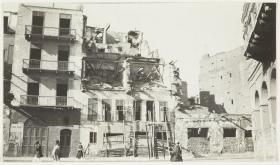Battle of the Wasser
WWI played an important role in the development of notions of Australia as a nation, particularly Australia’s national character and identity. The commemoration of the war saw the birth of the Anzac legend. The Battle of the Wasser challenges popular images of the Australian digger that revolve around characteristics of bravery and sacrifice, however, presenting a different perspective on the Anzac legend.
Key inquiry question #1
How does the role of Australian soldiers in the Battle of the Wasser fit with the image of the Australian digger?
Content
Significant events and the experiences of Australians at war (ACDSEH108)
Using sources, students investigate the following features of each war:
- a specific event/incident
Commemorations and the nature of the Anzac legend (ACDSEH097)
- explain different perspectives on the Anzac legend
Background Notes for Teachers and Students
Learning intention
Students are learning to:
- Evaluate the reliability and usefulness of primary sources, taking into account questions of origin, context and purpose
- Process and synthesise information from primary sources to be used as evidence when making an historical argument
- Recognise the role of perspective in historical interpretation
Success criteria
Students will be successful when they can:
- Create a comprehensive newspaper report that provides an account of the Battle of Wasser
- Analyse the range of perspectives of the event and put forward a historical argument for these differences in interpretation
- Evaluate the impact of the Battle of Wasser on the ANZAC legend
The Battle of the Wasser
On Good Friday in 1915, the 2 April, up to 2500 Anzac troops stationed near Cairo, Egypt, rioted in Haret Al Wassir, the red light district of Cairo. This incident became known variously as the Battle of the Wasser or Wozzer or Wazzir or Wossa, or similar. Taking place a couple of weeks before the Gallipoli campaign started, houses were ransacked, damaged and set on fire by the soldiers, and furniture thrown out of windows. Local firefighters were prevented from putting out the fires as the troops cut their hoses and set a fire engine alight. The British Military Police were called and shots were fired, resulting in the death of several soldiers and injury of more. It was well into the night before the military were able to restore order and subdue the fires.
Many reasons have been attributed to the riots, and the instigators similarly given differently depending on the source. It seems mostly likely that the riots were a reprisal for the spread of venereal disease, seen as the fault of the prostitutes of Cairo who inhabited the red light district. The army punished any soldier who caught this disease by suspending their pay while they received treatment, and sometimes also halting the payment of allowances to the soldier's dependents at home for the same period.
In the months prior to the Battle of the Wasser, reports were popping up in the newspapers in Australia raising questions about the conduct of the Australian soldiers in Egypt, generally.
Student Activities
Investigating the Battle of the Wasser
Students engage with diary entries, photographs and newspaper articles to investigate the Battle of the Wasser in its historical context, and consider its potential impact on the Anzac legend.

NSW Syllabus for the Australian Curriculum History K-10
A student:
- HT5-5 identifies and evaluates the usefulness of sources in the historical inquiry process
- HT5-7 explains different contexts, perspectives and interpretations of the modern world and Australia
Comprehension: chronology, terms and concepts
- read and understand historical texts
Analysis and use of sources
- evaluate the reliability and usefulness of primary and secondary sources for a specific historical inquiry (ACHHS171, ACHHS189)
Perspectives and interpretations
- identify and analyse the reasons for different perspectives in a particular historical context (ACHHS172, ACHHS173, ACHHS190, ACHHS191)
Contestability: historical sources, events or issues may be interpreted differently by historians depending on their perspectives and methods of inquiry
Comprehension: chronology, terms and concepts: read and understand historical texts
Analysis and use of sources: evaluate the reliability and usefulness of primary and secondary sources for a specific historical inquiry
Learning across the curriculum
- Civics and citizenship
- Ethical understanding
- Difference and diversity